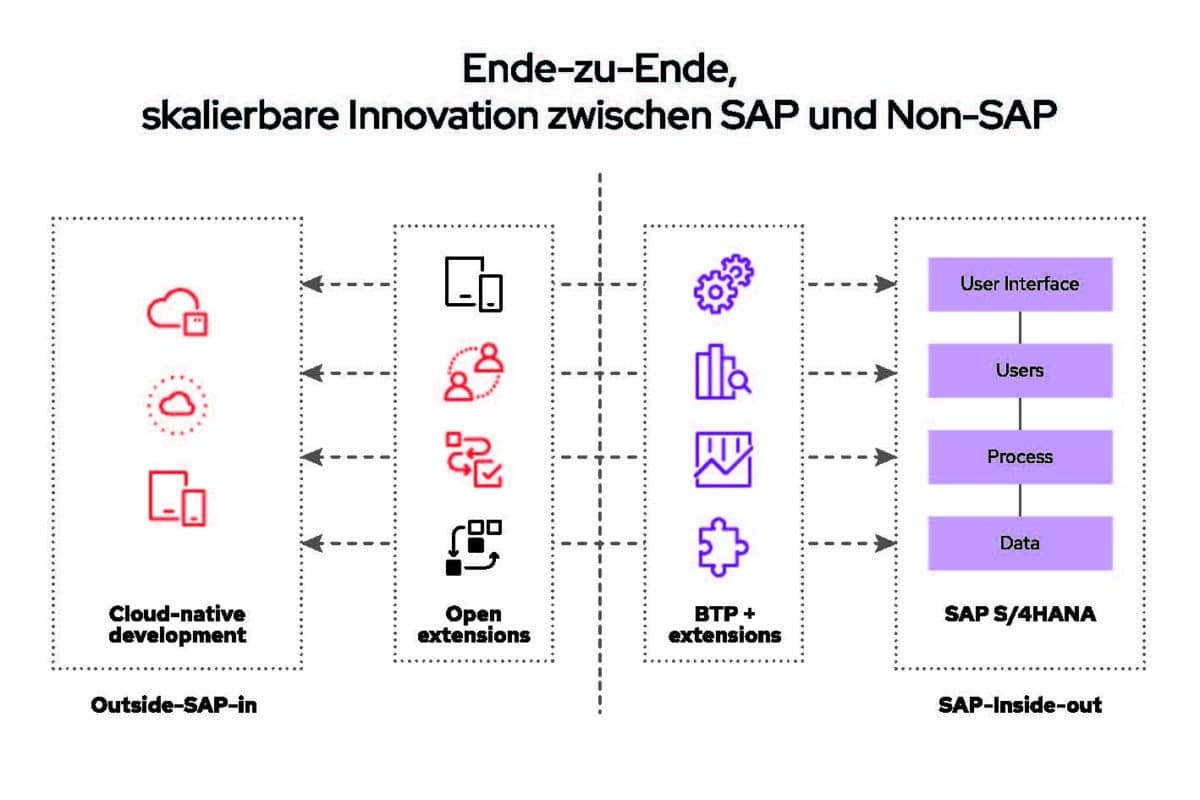Open Source Toolchain


When it comes to open source, many SAP customers think of the Linux operating system, which is mandatory as the foundation for the Hana database. But the range of open source products in the SAP community has grown. "More and more open source projects are now being extended to include SAP aspects, thus enabling new services," explains Red Hat's Peter Körner at the beginning of the E3 interview. Three examples illustrate the wide range of services that open source offers in the SAP context: automation, the SAP Linux Lab, and security. "In the area of automation, Ansible is worth mentioning," said Körner. "With the established Red Hat Ansible Automation Platform, an enterprise solution with support and certified content, companies can automate everything from the IT landscape to the SAP environment.
Hand in hand with this is the open source initiative of the SAP Linux Lab, which facilitates the automated creation and management of SAP environments. It is based on standardized and modular code and tools developed and provided by SAP's technology partners. In the area of security, for example, the use of SELinux (Security Enhanced Linux) is now also certified for productive SAP instances. Also worth mentioning is Red Hat Insights, which includes proprietary rule sets for use within SAP. The service provides risk analysis, proactive infrastructure management, and automated remediation of potential software security and configuration issues. With a focus on operations, security, and business, this service analyzes platforms and applications for security and performance risks, enabling better management of SAP landscapes.
Hand in hand with this is the open source initiative of the SAP Linux Lab, which facilitates the automated creation and management of SAP environments. This is based on standardized and modular codes and tools developed and provided by SAP technology partners. With regard to security, for example, the use of SELinux (Security Enhanced Linux) is now also certified for productive SAP instances. Also worth mentioning is Red Hat Insights, which includes its own rule sets for use in SAP. The service provides risk analysis, proactive infrastructure management, and automatic remediation of potential software security and configuration issues. With a focus on operations, security, and business, this service analyzes platforms and applications for security and performance risks, enabling better management of SAP landscapes.

End-to-end SAP integration, scalable innovation and cloudnative application development.
ERP modernization
With Hana and S/4, modernization is also expected in the ERP landscape. Can open source practices and products contribute to this modernization of the ERP architecture? "With open source principles, many problems and stumbling blocks in SAP modernizations and migrations can be avoided right from the start," says Peter Körner, adding, "Real-time transparency for all participants, adaptability, and collaboration during the project period form the basis for an ecosystem tool chain for S/4 and Rise projects that is currently emerging in the German-speaking region. On the one hand, these projects in the SAP community are based on an end-to-end IT platform for modernization on an open source basis—for example to address issues such as process adaptations, change management, interfaces, API management, legacy code, proprietary developments, data lakes, historization, hybrid cloud scenarios or non-SAP integrations. "This IT foundation creates a lot of synergies, so that business departments, IT departments, partner companies and many other stakeholders, who previously worked in complete isolation, can communicate and plan with each other," emphasizes Red Hat's Körner in the E3 interview.
Transformation and Quick Wins
In contrast to traditional transformation projects, the key feature of an integrated ecosystem toolchain is the continuous sharing of information, facts, insights and techniques throughout all project phases according to open source principles. Different departments share analysis results and project parameters, everyone leverages results and quick wins, and target platform specifications are automatically passed on to the next stakeholder.
The SAP community's knowledge and ability to act will allow this ecosystem to emerge with the help of open source. Professor August-Wilhelm Scheer will soon be publishing a book that describes this very future: The Composable Enterprise. The alternative to traditional ERP and the associated project work is the ERP that SAP and the open source community put together. SAP will continue to contribute to the FI/CO module. AI and IoT functionality will come from hyperscalers. End-to-end processes will be independently customized by the SAP community based on the SAP Business Technology Platform with steampunk (embedded Abap) and an ecosystem toolchain. Composable Enterprise is the alternative to traditional ERP architectures. SAP customers will define the next generation of ERP with open source tools.
What does open source offer? A framework of IT tools or strategic recommendations? Peter Körner defines: "Open source is not just about solutions, tools, technologies, and frameworks; it is also about principles such as openness, flexibility, independence, and freedom of choice to implement even highly complex projects at high speed and scale. These principles can also serve as recommendations for SAP modernization.
Hybrid cloud without lock-ins
The open source approach, which aligns technology, processes, and culture, is a key driver of digital transformation, and there is no alternative for SAP customers. According to Peter Körner, open source provides the independence to implement a true hybrid cloud strategy, as well as a high degree of strategic flexibility without lock-ins, which is becoming increasingly important in light of rapidly evolving markets and regulatory requirements. Just think of DORA, the Supply Chain Due Diligence Act, or the Digital Product Passport, or sustainability requirements.
The myth created with SAP R/3 is that all business and organizational functions should be integrated and ultimately have a single point of truth. At the same time, the ERP construct should also have degrees of freedom for diversification. With the three-tier client-server model, Professor Hasso Plattner succeeded in achieving perfect ERP integration, and at the same time SAP developed Abap as an IT tool for the necessary diversification. The structure and process organization of every company can thus be mapped within IT. A current discourse of the German-speaking SAP user association DSAG shows the following: A Business Technology Platform must be functionally convincing and not only aim at dazzling with innovative technology. The business aspect is the competitive advantage for SAP customers.
A digital transformation of the organizational structure and processes cannot be achieved by a technical release upgrade. The system design of an ERP can be based on SAP components, but its essence will be composite IT solutions with an ecosystem toolchain. Composability will define future ERP architectures. Platforms will become even more important because they represent homogeneity. SAP's shift to open source platforms, democratic programming models, and AI and machine learning will quickly move SAP customers forward in their digital transformation.
Composable ERP has a bit of cybernetics to it and is about the interrelationships of components. A highly composable system provides SAP customers with ERP components that can be assembled in different combinations to meet user needs. With an ecosystem toolchain, the SAP partner landscape will also change in a revolutionary way, as any kind of dependency and monopoly will disappear. Accordingly, composable ERP does not mean that every SAP legacy customer will be free to do as they please, but rather that there will be a common contextual understanding—a toolchain—across the SAP community. This composability will be a principle of ERP system design and a feature that belongs to the community. SAP and many other IT vendors will become tool providers.
In terms of modernization, how important are open source tools? How important are the experts who can use them? What should SAP customers be aware of? "Open source stands for innovation and is an integral part of the SAP world," says Peter Körner. Almost every player in the SAP ecosystem, be it a partner, an independent software vendor, or an add-on vendor, is embracing open source. However, caution is called for when choosing a solution or partner, says Red Hat's Körner: "Even if open source stands for high flexibility and interoperability in principle, its use is not always a trivial matter. Especially for productive use in a company's own development and operations, more is needed than just the download file from the open source community. Tried and tested guidelines for the secure and sensible use of open source can help customers. There are also many technology frameworks that simplify the modernization of the application landscape.
Enterprise-ready solution
It is important to be aware of frameworks that are supported only by small communities, which do not guarantee continuous development. Such frameworks are problematic for mission-critical applications. As a result, customers should instead select carefully curated, enterprise-ready solutions based on open source software, especially in terms of infrastructure and technology foundations, including support services and certifications. For SAP, this means components such as the Linux operating system, Ansible automation, API management, or the layers of a hybrid multi-cloud architecture," says Peter Körner.
Peter concludes his E3 interview by saying, "There is no question that open source solutions and technologies are the key drivers of modernization. Almost all innovations such as cloud, big data, artificial intelligence, machine learning and the Internet of Things are the result of open source ecosystems. "And SAP and SAP partners cannot ignore this development if they want to strengthen their competitiveness and increase their agility and flexibility," says Peter Körner. "In addition, customers should not overlook the fact that the added value of a solution no longer lies in the technical foundation, but in the orchestration of a complex world of new techniques and possibilities, which open source platforms serve as the basis for. Open source business models are here to stay, old silo thinking no longer works, and remaining open is now even more important than ever.






